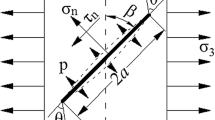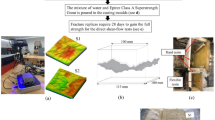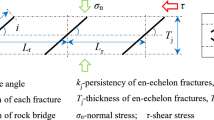Abstract
Pre-existing fractures in rock engineering significantly affect the entire structural stability. To deepen the understanding of the fracture mechanism of fractured rocks under shear loading, a numerical study based on the distinct element method was conducted to investigate the shear behaviors of rock fractures. A discrete element model with fractures of Barton's ten standard profiles was established, and shear simulations under different normal stresses and joint roughness coefficient (JRC) were carried out. The simulation results show that the shear stress–displacement curve can be divided into three stages: elastic loading stage, inelastic stage and stress drop stage. The shear strength, internal friction angle and cohesion increase with the increase of normal stress and JRC. These macroscopic mechanical characteristics are consistent with the results of previous experimental studies. Most of the microcracks generated during the shearing process are tensile microcracks, which are first formed at the steep position of the fracture profile line, and the proportion of shear microcracks is less than 10%. In addition, the contact force between particles is mainly compressive stress, which is greater in magnitude and density than tensile stress. As the shear proceeds, the displacement of the particles gradually changes from non-uniform distribution to uniform distribution.















Similar content being viewed by others
Data availability
Data will be made available on request.
References
Wang SY, Sloan SW, Sheng DC, Yang SQ, Tang CA (2014) Numerical study of failure behaviour of pre-cracked rock specimens under conventional triaxial compression. Int J Solids Struct 51(5):1132–1148. https://doi.org/10.1016/j.ijsolstr.2013.12.012
Zhao YL, Zhang CS, Wang YX, Lin H (2021) Shear-related roughness classification and strength model of natural rock joint based on fuzzy comprehensive evaluation. Int J Rock Mech Min Sci. https://doi.org/10.1016/j.ijrmms.2020.104550
Khosravi A, Serej AD, Mousavi SM, Haeri SM (2016) Effect of hydraulic hysteresis and degree of saturation of infill materials on the behavior of an infilled rock fracture. Int J Rock Mech Min Sci 88:105–114. https://doi.org/10.1016/j.ijrmms.2016.07.001
Jiang M, Liu J, Crosta GB, Li T (2017) DEM analysis of the effect of joint geometry on the shear behavior of rocks. CR Mécanique 345(11):779–796. https://doi.org/10.1016/j.crme.2017.07.004
Wu H, Fan A, Ma D, Spearing AJS, Zheng Z (2023) Fracturing process and initiation mechanism of hard rock tunnels with different shapes: particle flow modeling and analytical study. Comput Part Mech. https://doi.org/10.1007/s40571-023-00594-x
Li Y, Chen L, Wang Y (2005) Experimental research on pre-cracked marble under compression. Int J Solids Struct 42(9):2505–2516. https://doi.org/10.1016/j.ijsolstr.2004.09.033
Hoek E, Martin CD (2014) Fracture initiation and propagation in intact rock—A review. J Rock Mech Geotech 6(4):287–300
Zhang YC, Jiang YJ, Asahina D, Wang Z (2020) Shear behavior and acoustic emission characteristics of en-echelon joints under constant normal stiffness conditions. Theor Appl Fract Mec. https://doi.org/10.1016/j.tafmec.2020.102772
Wang JG, Schweizer D, Liu QB, Su AJ, Hu XL, Blum P (2021) Three-dimensional landslide evolution model at the Yangtze River. Eng Geol. https://doi.org/10.1016/j.enggeo.2021.106275
Indraratna B, Oliveira DAF, Brown ET (2010) A shear-displacement criterion for soil-infilled rock discontinuities. Geotechnique 60(8):623–633. https://doi.org/10.1680/geot.8.P.094
Indraratna B, Ranjith PG (2001) Laboratory measurement of two-phase flow parameters in rock joints based on high pressure triaxial testing. J Geotech Geoenviron 127(6):530–542. https://doi.org/10.1061/(asce)1090-0241(2001)127:6(530)
Indraratna B, Oliveira DAF, Brown ET, de Assis AP (2010) Effect of soil–infilled joints on the stability of rock wedges formed in a tunnel roof. Int J Rock Mech Min Sci 47(5):739–751. https://doi.org/10.1016/j.ijrmms.2010.05.006
Ellsworth WL (2013) Injection-induced earthquakes. Science 341(6142):142. https://doi.org/10.1126/science.1225942
Bao XW, Eaton DW (2016) Fault activation by hydraulic fracturing in western Canada. Science 354(6318):1406–1409. https://doi.org/10.1126/science.aag2583
Singh M, Seshagiri RK (2005) Empirical methods to estimate the strength of jointed rock masses. Eng Geol 77(1):127–137. https://doi.org/10.1016/j.enggeo.2004.09.001
Mohammadnejad M, Fukuda D, Liu HY, Dehkhoda S, Chan A (2020) GPGPU-parallelized 3D combined finite–discrete element modelling of rock fracture with adaptive contact activation approach. Comput Part Mech 7(5):849–867. https://doi.org/10.1007/s40571-019-00287-4
Han W, Jiang Y, Luan H, Du Y, Zhu Y, Liu J (2020) Numerical investigation on the shear behavior of rock-like materials containing fissure-holes with FEM-CZM method. Comput Geotech 125:103670. https://doi.org/10.1016/j.compgeo.2020.103670
Zou Z, Hameed M (2018) Combining interface damage and friction in cohesive interface models using an energy based approach. Compos Part A-appl S 112:290–298. https://doi.org/10.1016/j.compositesa.2018.06.017
Zhang JZ, Zhou XP, Zhou LS, Berto F (2019) Progressive failure of brittle rocks with non-isometric flaws: insights from acousto-optic-mechanical (AOM) data. Fatigue Fract Eng M 42(8):1787–1802. https://doi.org/10.1111/ffe.13019
Develi K (2020) Computation of direction dependent joint surface parameters through the algorithm of triangular prism surface area method: a theoretical and experimental study. Int J Solids Struct 202:895–911. https://doi.org/10.1016/j.ijsolstr.2020.06.038
Chen W, Wan W, Zhao Y, Peng W (2020) Experimental study of the crack predominance of rock-like material containing parallel double fissures under uniaxial compression. Sustainability 12(12):5188
Zhao YL, Tang JZ, Chen Y, Zhang LY, Wang WJ, Wan W et al (2017) Hydromechanical coupling tests for mechanical and permeability characteristics of fractured limestone in complete stress-strain process. Environ Earth Sci. https://doi.org/10.1007/s12665-016-6322-x
Agharazi A, Tannant D, Martin CD (2012) Characterizing rock mass deformation mechanisms during plate load tests at the Bakhtiary dam project. Int J Rock Mech Min Sci 49:1–11. https://doi.org/10.1016/j.ijrmms.2011.10.002
Sanei M, Faramarzi L, Fahimifar A, Goli S, Mehinrad A, Rahmati A (2015) Shear strength of discontinuities in sedimentary rock masses based on direct shear tests. Int J Rock Mech Min Sci 75:119–131. https://doi.org/10.1016/j.ijrmms.2014.11.009
Han G, Zhang C, Zhou H, Zhang C, Gao Y, Singh HK (2021) A new predictive method for the shear strength of interlayer shear weakness zone at field scales. Eng Geol 295:106449. https://doi.org/10.1016/j.enggeo.2021.106449
Wang YN, Bui HH, Nguyen GD, Ranjith PG (2019) A new SPH-based continuum framework with an embedded fracture process zone for modelling rock fracture. Int J Solids Struct 159:40–57. https://doi.org/10.1016/j.ijsolstr.2018.09.019
Wang J, Li JT, Shi ZM (2022) Crack evolution law and failure mode of red sandstone under fatigue-creep interaction. Fatigue Fract Eng M 45(1):270–284. https://doi.org/10.1111/ffe.13599
Zhou XP, Xia EM, Yang HQ, Qian QH (2012) Different crack sizes analyzed for surrounding rock mass around underground caverns in Jinping I hydropower station. Theor Appl Fract Mec 57(1):19–30. https://doi.org/10.1016/j.tafmec.2011.12.004
Goudie AS (2016) Quantification of rock control in geomorphology. Earth Sci Rev 159:374–387. https://doi.org/10.1016/j.earscirev.2016.06.012
Xie S, Lin H, Duan H (2023) A novel criterion for yield shear displacement of rock discontinuities based on renormalization group theory. Eng Geol. https://doi.org/10.1016/j.enggeo.2023.107008
Xie S, Lin H, Duan H, Chen Y (2023) Modeling description of interface shear deformation: A theoretical study on damage statistical distributions. Constr Build Mater 394:132052. https://doi.org/10.1016/j.conbuildmat.2023.132052
Barla G, Robotti F, Vai L, editors. (2011) Revisiting large size direct shear testing of rock mass foundations. 6th international conference on dam engineering, Lisbon, Portugal. LNEC, Lisbon
Vorobiev O (2008) Generic strength model for dry jointed rock masses. Int J Plast 24(12):2221–2247. https://doi.org/10.1016/j.ijplas.2008.06.009
Xie S, Lin H, Chen Y, Duan H, Liu H, Liu B (2023) Prediction of shear strength of rock fractures using support vector regression and grid search optimization. Mater Today Commun 36:106780. https://doi.org/10.1016/j.mtcomm.2023.106780
Muralha J, Grasselli G, Tatone B, Blümel M, Chryssanthakis P, Yujing J (2014) ISRM suggested method for laboratory determination of the shear strength of rock joints: revised version. Rock Mech Rock Eng 47(1):291–302
Patton FD, editor. Multiple modes of shear failure in rock. 1st ISRM Congress; 1966: OnePetro
Barton N (1973) Review of a new shear-strength criterion for rock joints. Eng Geol 7(4):287–332. https://doi.org/10.1016/0013-7952(73)90013-6
Isrm I (1978) Suggested methods for the quantitative description of discontinuities in rock masses. Int J Rock Mech Min Sci Geomech Abstr 15(6):319–368
Jafari MK, Amini Hosseini K, Pellet F, Boulon M, Buzzi O (2003) Evaluation of shear strength of rock joints subjected to cyclic loading. Soil Dyn Earthq Eng 23(7):619–630. https://doi.org/10.1016/S0267-7261(03)00063-0
Kleepmek M, Khamrat S, Thongprapha T, Fuenkajorn K (2016) Displacement velocity effects on rock fracture shear strengths. J Struct Geol 90:48–60. https://doi.org/10.1016/j.jsg.2016.07.007
Singh HK, Basu A (2018) Evaluation of existing criteria in estimating shear strength of natural rock discontinuities. Eng Geol 232:171–181. https://doi.org/10.1016/j.enggeo.2017.11.023
Barton N, Wang C, Yong R (2023) Advances in joint roughness coefficient (JRC) and its engineering applications. J Rock Mech Geotech. https://doi.org/10.1016/j.jrmge.2023.02.002
Barton N, Choubey V (1977) The shear strength of rock joints in theory and practice. Rock Mech 10(1–2):1–54. https://doi.org/10.1007/BF01261801
Wang G, Wu XL, Zhang XD, Zhang ZS, Zhao ZP, Han W et al (2020) Macro-microscopic study on the shear characteristics of filled joints with different roughnesses. Arab J Sci Eng 45(10):8331–8348. https://doi.org/10.1007/s13369-020-04705-1
Day JJ, Diederichs MS, Hutchinson DJ (2017) New direct shear testing protocols and analyses for fractures and healed intrablock rockmass discontinuities. Eng Geol 229:53–72. https://doi.org/10.1016/j.enggeo.2017.08.027
Xie S, Lin H, Chen Y (2022) New constitutive model based on disturbed state concept for shear deformation of rock joints. Arch Civ Mech Eng 23(1):26. https://doi.org/10.1007/s43452-022-00560-z
Fakhimi A, Norouzi S (2019) Dilation angle in bonded particle simulation of rock. Comput Part Mech 6(2):195–211. https://doi.org/10.1007/s40571-018-0208-5
Gong L, Nemcik J, Ren T (2018) Numerical simulation of the shear behavior of rock joints filled with unsaturated soil. Int J Geomech 18(9):04018112. https://doi.org/10.1061/(ASCE)GM.1943-5622.0001253
Li H, Wong LNY (2012) Influence of flaw inclination angle and loading condition on crack initiation and propagation. Int J Solids Struct 49(18):2482–2499
Zhou X, Chen J (2019) Extended finite element simulation of step-path brittle failure in rock slopes with non-persistent en-echelon joints. Eng Geol 250:65–88. https://doi.org/10.1016/j.enggeo.2019.01.012
Wang Y, Zhou X, Wang Y, Shou Y (2018) A 3-D conjugated bond-pair-based peridynamic formulation for initiation and propagation of cracks in brittle solids. Int J Solids Struct 134:89–115. https://doi.org/10.1016/j.ijsolstr.2017.10.022
Duriez J, Darve F, Donzé FV (2011) A discrete modeling-based constitutive relation for infilled rock joints. Int J Rock Mech Min Sci 48(3):458–468. https://doi.org/10.1016/j.ijrmms.2010.09.008
Lee H, Jeon S (2011) An experimental and numerical study of fracture coalescence in pre-cracked specimens under uniaxial compression. Int J Solids Struct 48(6):979–999. https://doi.org/10.1016/j.ijsolstr.2010.12.001
Cundall PA, Hart RD (1992) Numerical modelling of discontinua. Eng Computation.
Li Z, Rao QH (2021) Quantitative determination of PFC3D microscopic parameters. J Cent South Univ 28(3):911–925. https://doi.org/10.1007/s11771-021-4653-6
Zhou XP, Zhang JZ, Yang SQ, Berto F (2021) Compression-induced crack initiation and growth in flawed rocks: a review. Fatigue Fract Eng M 44(7):1681–1707. https://doi.org/10.1111/ffe.13477
Cundall PA (2000) Numerical experiments on rough joints in shear using a bonded particle model. In: Lehner FK, Urai JL, editors. Aspects of Tectonic Faulting: In Honour of Georg Mandl. Berlin, Heidelberg: Springer Berlin Heidelberg p. 1–9
Park J-W, Song J-J (2009) Numerical simulation of a direct shear test on a rock joint using a bonded-particle model. Int J Rock Mech Min Sci 46(8):1315–1328. https://doi.org/10.1016/j.ijrmms.2009.03.007
Bahaaddini M, Sharrock G, Hebblewhite BK (2013) Numerical direct shear tests to model the shear behaviour of rock joints. Comput Geotech 51:101–115. https://doi.org/10.1016/j.compgeo.2013.02.003
Shi C, Xu W (2015) Techniques and practice for numerical simulation of particle flow. China Building Construction Industry Press, Beijing, China
Xie S, Lin H, Cheng C, Chen Y, Wang Y, Zhao Y et al (2022) Shear strength model of joints based on Gaussian smoothing method and macro-micro roughness. Comput Geotech 143:104605. https://doi.org/10.1016/j.compgeo.2021.104605
Cundall PA, Strack OD (1979) A discrete numerical model for granular assemblies. Geotechnique 29(1):47–65
Tarokh A, Fakhimi A (2014) Discrete element simulation of the effect of particle size on the size of fracture process zone in quasi-brittle materials. Comput Geotech 62:51–60. https://doi.org/10.1016/j.compgeo.2014.07.002
Yue Z, Meng F, Zhou X, Wang X, Zhang L, Wang Z (2022) Influence of non-persistent joint aperture and inclination angle on the shear behavior and fracture mode of solid rock and concrete material. Constr Build Mater 316:125892. https://doi.org/10.1016/j.conbuildmat.2021.125892
Poulsen BA, Adhikary D, Guo H (2018) Simulating mining-induced strata permeability changes. Eng Geol 237:208–216. https://doi.org/10.1016/j.enggeo.2018.03.001
Li K, Han D, Fan X, Yang Y, Wang F (2022) Shear rupture behaviors of intact and granulated Wombeyan marble with the flat-jointed model. Arch Civ Mech Eng 22(1):51. https://doi.org/10.1007/s43452-022-00377-w
Itasca Consulting Group I (2014) PFC—Particle Flow Code, Ver. 5.0. Itasca Minneapolis
Coetzee CJ (2017) Calibration of the discrete element method. Powder Technol 310:104–142. https://doi.org/10.1016/j.powtec.2017.01.015
Sharrock B, Akram M, Mitra R (2009) Application of synthetic rock mass modeling to estimate the strength of jointed sandstone. 43rd US Rock Mechanics Symposium and 4th US-Canada Rock Mechanics Symposium
Ding X, Zhang L, Zhu H, Zhang Q (2014) Effect of model scale and particle size distribution on PFC3D simulation results. Rock Mech Rock Eng 47(6):2139–2156. https://doi.org/10.1007/s00603-013-0533-1
Bahaaddini M, Hagan PC, Mitra R, Khosravi MH (2016) Experimental and numerical study of asperity degradation in the direct shear test. Eng Geol 204:41–52. https://doi.org/10.1016/j.enggeo.2016.01.018
Xie SJ, Lin H, Chen YF, Yong R, Xiong W, Du SG (2020) A damage constitutive model for shear behavior of joints based on determination of the yield point. Int J Rock Mech Min Sci. https://doi.org/10.1016/j.ijrmms.2020.104269
Meng F, Wong LNY, Guo T (2022) Frictional behavior and micro-damage characteristics of rough granite fractures. Tectonophysics 842:229589. https://doi.org/10.1016/j.tecto.2022.229589
Nasir O, Fall M (2008) Shear behaviour of cemented pastefill-rock interfaces. Eng Geol 101(3):146–153. https://doi.org/10.1016/j.enggeo.2008.04.010
Xu W, Lin H, Cao R (2018) Simulation and macro-mesoscopic parameter analysis for direct shear of filled rough joints. J Southwest Jiaotong Univ 53(3):548–557
Gu Xue F, Seidel Julian P, Haberfield CM (2003) Direct shear test of sandstone-concrete joints. Int J Geomech 3(1):21–33. https://doi.org/10.1061/(ASCE)1532-3641(2003)3:1(21)
Jiang YJ, Wang YH, Yan P, Luan HJ, Chen YQ (2019) Experimental investigation on the shear properties of heterogeneous discontinuities. Geotech Geol Eng 37(6):4959–4968. https://doi.org/10.1007/s10706-019-00955-5
Yin T-B, Zhuang D-D, Li M-J, Li X-B (2022) Numerical simulation study on the thermal stress evolution and thermal cracking law of granite under heat conduction. Comput Geotech 148:104813. https://doi.org/10.1016/j.compgeo.2022.104813
Dang Y, Yang Z, Liu X, Lu C (2023) Numerical study on failure mechanism and acoustic emission characteristics of granite after thermal treatment. Comput Part Mech 10(5):1245–1266. https://doi.org/10.1007/s40571-023-00556-3
Eftekhari M, Baghbanan A, Hashemolhosseini H, Amrollahi H (2015) Mechanism of fracture in macro- and micro-scales in hollow centre cracked disc specimen. J Cent South Univ 22(11):4426–4433. https://doi.org/10.1007/s11771-015-2990-z
Acknowledgements
This paper gets its funding from Projects (42277175) supported by National Natural Science Foundation of China and the Postgraduate Research & Practice Innovation Program of Jiangsu Province (No. KYCX23_0276).
Author information
Authors and Affiliations
Contributions
SX: Methodology, Data curation, Writing—original draft. Hang Lin: Investigation, Supervision, Funding acquisition. HD: Conceptualization, Writing—original draft. HL: Investigation. BL: Writing—review & editing. All authors read and approved the final manuscript.
Corresponding author
Ethics declarations
Conflict of interest
The authors declare no competing interests.
Additional information
Publisher's Note
Springer Nature remains neutral with regard to jurisdictional claims in published maps and institutional affiliations.
Rights and permissions
Springer Nature or its licensor (e.g. a society or other partner) holds exclusive rights to this article under a publishing agreement with the author(s) or other rightsholder(s); author self-archiving of the accepted manuscript version of this article is solely governed by the terms of such publishing agreement and applicable law.
About this article
Cite this article
Xie, S., Lin, H., Duan, H. et al. Numerical study on cracking behavior and fracture failure mechanism of fractured rocks under shear loading. Comp. Part. Mech. 11, 903–920 (2024). https://doi.org/10.1007/s40571-023-00660-4
Received:
Revised:
Accepted:
Published:
Issue Date:
DOI: https://doi.org/10.1007/s40571-023-00660-4




